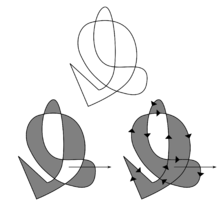Even–odd rule

The even–odd rule is an algorithm implemented in vector-based graphic software,[1] like the PostScript language and Scalable Vector Graphics (SVG), which determines how a graphical shape with more than one closed outline will be filled. Unlike the nonzero-rule algorithm, this algorithm will alternatively color and leave uncolored shapes defined by nested closed paths irrespective of their winding.
The SVG specification says: "This rule determines the "insideness" of a point on the canvas by drawing a ray from that point to infinity in any direction and counting the number of path segments from the given shape that the ray crosses. If this number is odd, the point is inside; if even, the point is outside."
The rule can be seen in effect in many vector graphic programs (such as Freehand or Illustrator), where a crossing of an outline with itself causes shapes to fill in strange ways.
On a simple curve, the even–odd rule reduces to a decision algorithm for the point in polygon problem.
Implementation
Below is an example implementation in Python:[2]
def isPointInPath(x, y, poly):
"""
x, y -- x and y coordinates of point
poly -- a list of tuples [(x, y), (x, y), ...]
"""
num = len(poly)
i = 0
j = num - 1
c = False
for i in range(num):
if ((poly[i][1] > y) != (poly[j][1] > y)) and \
(x < poly[i][0] + (poly[j][0] - poly[i][0]) * (y - poly[i][1]) /
(poly[j][1] - poly[i][1])):
c = not c
j = i
return c
References
- ↑ J. D. Foley, A. van Dam, S. K. Feiner, and J. F. Hughes. Computer Graphics: Principles and Practice. The Systems Programming Series. Addison-Wesley, Reading, 2nd edition, 1990.
- ↑ http://www.ecse.rpi.edu/Homepages/wrf/Research/Short_Notes/pnpoly.html
External links